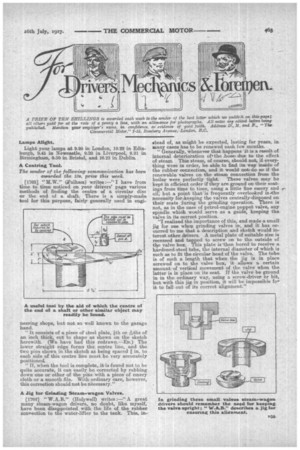Lamps Aright.
Page 19

If you've noticed an error in this article please click here to report it so we can fix it.
Light your lamps at 9.20 in London, 10.22 in Edinburgh, 9.41 in Newcastle 9.39 in Liverpool, 9.31 in Birmingham, 9.30 in Bristol, and 10.23 in Dublin.
A Centring Tool.
The sender of the following communication has been awarded the igs. prize this week.
[1763] " M.W." (Zulham) writes :—" I have from time to time noticed on your drivers' page various methods of finding the centre of a circular disc or the end of a shaft. There is a simply-made tool for this purpose, fairly generally used in engi neering shops, but not so well known to the garage hand.
" It consists of a piece of steel plate, ith or Aths of an inch thick, cut to shape as shown on the sketch herewith. (We have had this redrawn.--En.) The lower straight edge forms the centre line, and the two pins shown in the sketch as being spaced I in, to each side of this centre line must be very accurately positioned.
"if, when the tool is complete, it is found not to be quite accurate, it can easily be corrected by rubbing down one or other of the pins with a piece of emery cloth or a smooth file. With ordinary care, however, this correction should not be necessary."
A Jig for Grinding Steam-wagon Valves, [1764] " W.A.B." (Holywell) *rites :—" A great many steam-wagon drivers, no doubt, like myself, have been disappointed with the life of the rubber connection to the water-lifter to the tank. This, in
stead of, as might be expected, lasting for years, in many has to be renewed each few months.
e nerally, whenever that happens it is a, result of internal deterioration oftthe hosedue to the effect of steam. This steam, of course, should not, if everything were in order, be able to find its way inside of the rubber connection, and it would not, do so if the renewable valves on the steam connection from the boiler were perfectly tight. These valves may be kept in efficient order if they are ground on their seatlugs from time to time, using a little fine emery and oil; but a point that"is frequently overlooked is-the necessity forlkeeping the valves centrally-disposed on their seats during the grinding operation. There is not, as in the case of petrol-engine poppet valve, any spindle whieh would serve as a guide, keeping the valve in its correct position. "I realised the importance of this, and made a small jig for use when grinding valves in, and it has occurred-to me that a description and sketch would interest other. drivers. A metal plate of suitable size is recessed and tapped to screw on to the outside of the valve box. This plate is Ilken bored to receive a hgrdened-steel tube, the internal diameter of which is such as to fit the circular head of the valve. The tube is of such a length that when the jig is in place screwed on to the valve box, it allows a certain amount of vertical movement of the valve when the latter is in place on its seat. If the valve be ground in in the ordinary way, using a screw-driver, or bit, but with this jig in position, it will be impossible fo,. it to fall out of its correct alignment."




















